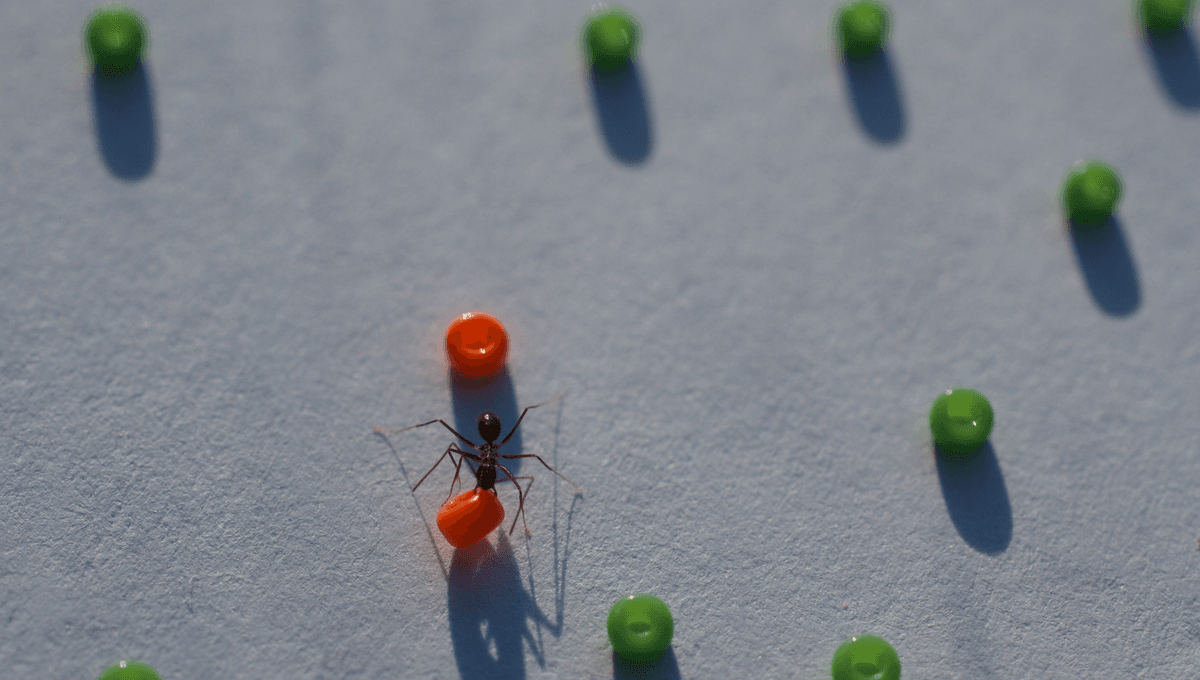“Swarm Intelligence” Sees Longhorn Crazy Ants Clear The Path For Nestmates

“Swarm Intelligence” Sees Longhorn Crazy Ants Clear The Path For Nestmates
The coordination shown by tiny-brained ants is even more remarkable than has previously been recognized. Film footage shows longhorn crazy ants apparently anticipating the path others will need to take to bring food back to the nest, and removing obstacles to make it easier, but the real thinking is collective.
Longhorn crazy ants (Paratrechina longicornis) are something of a model species when it comes to studying the way tiny brains can cooperate to remarkable effect. One study showed how they coordinate to carry loads far too heavy for any one individual – something few supposedly “higher animals” can manage. Experiments with Lego obstacles have revealed that the ants sometimes collectively recognize they need a new approach when what they are doing isn’t working. Scent-detectors reveal P. longicornis has special fast-evaporating scent to mark trails for those carrying loads too big to fit the normal way. Besides the value in understanding our world a little better, this research is thought to potentially contribute to better robot coordination. When comrades are struggling with a difficult task, it seems natural to rush in and lend a hand (or mandible). Coaches of certain team sports have to overcome this tendency in young players, but it seems the ants have worked out that there are often better ways to be of assistance. “Here we show for the first time that workers of the longhorn crazy ant can clear obstacles from a path before they become a problem – anticipating where a large food item will need to go and preparing the way in advance. This is the first documented case of ants showing such forward-looking behavior during cooperative transport,” Dr Ehud Fonio of the Weizmann Institute of Science said in a statement. Fonio and colleagues were startled to see worker crazy ants pick up pebbles and move them out of the way of other workers struggling to bring a large insect back to the nest, where its body would provide a feast. “When we first saw ants clearing small obstacles ahead of the moving load we were in awe. It appeared as if these tiny creatures understand the difficulties that lie ahead and try to help their friends in advance,” said Professor Ofer Feinerman. The two circled ants (a) are removing bits of gravel from the path of the food. When beads are used instead, those that most interfere with the path are the ones taken. Image Credit: Fonio et al., Frontiers in Behavioral Neuroscience, 2025 (CC BY 4.0) Using cat food and plastic beads, the authors ran 83 experiments to see under what conditions ants would move obstacles, rather than providing extra lift or marking trails. The beads were an effective test, in one case slowing food delivery down by a factor of 15, worse than a large traffic snarl for the pizza you ordered. Although the ants sometimes removed beads that could have been safely left, on average, the process reduced food delivery times. Not surprisingly, beads were most likely to be removed when they lay between the food and the nest, particularly when they lay about 40 millimeters (1.6 inches) ahead of the food. (For comparison, the ants are about 2.5 mm (0.1 inches) long, and some removalists had not even encountered the food). Ants’ apparent tirelessness is not a mirage – one champion ant cleared 64 beads rather than have the food carriers bump into them. A single drop of pheromone placed near a bead sent a quarter of the ants that cleared the nearest bead into what the authors call “clearing mode”, removing not only that bead, but all others between the food and nest. The ants also appear good at recognizing when obstacle clearing is required, being much more likely to clear when their nestmates were carrying a large load than one divided into smaller portions that made the obstacles easier to avoid. Again, it seems pheromone drops told them when needed to bother. “Taken together, these results imply that our initial impression was wrong: in reality, individual workers don’t understand the situation at all. This intelligent behavior happens at the level of the colony, not the individual. Each ant follows simple cues – like fresh scent marks left by others – without needing to understand the bigger picture, yet together they create a smart, goal-directed outcome,” said Dr Danielle Mersch. Feinerman compares each ant to a neuron in the brain, which on its own knows little, but through cooperation brings cognition and planning to life. The study is open access in Frontiers in Behavioral Neuroscience.


